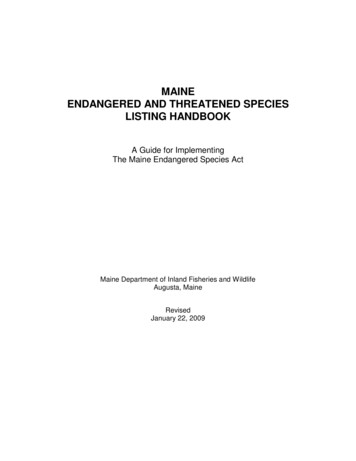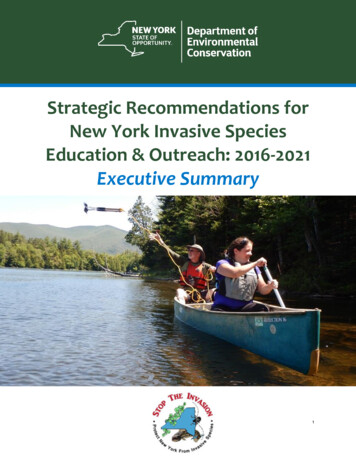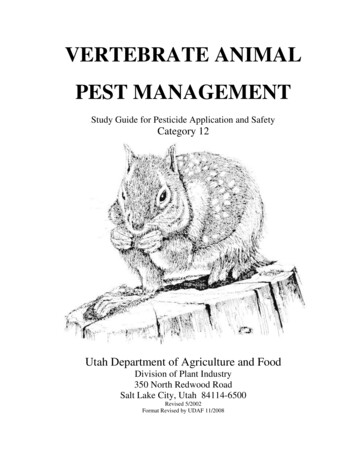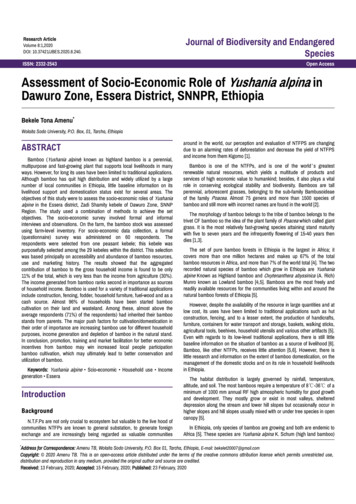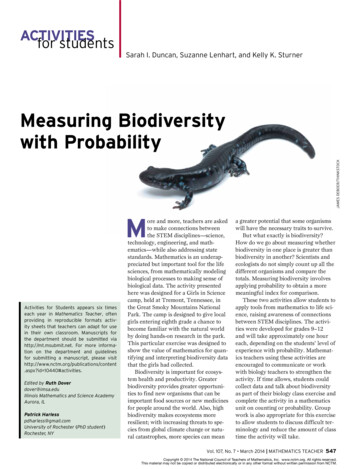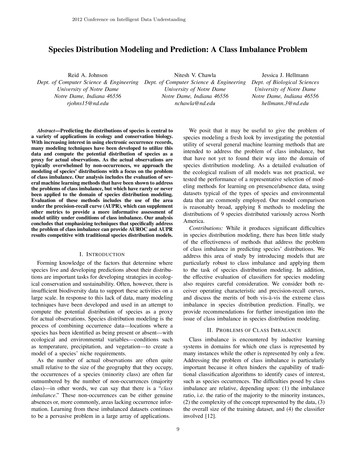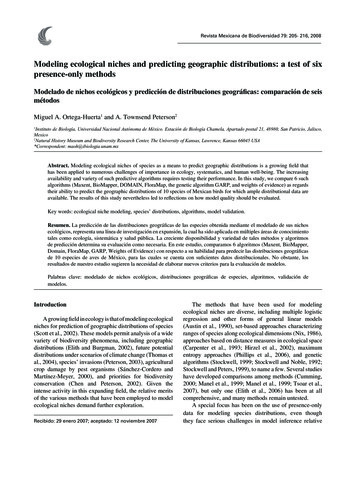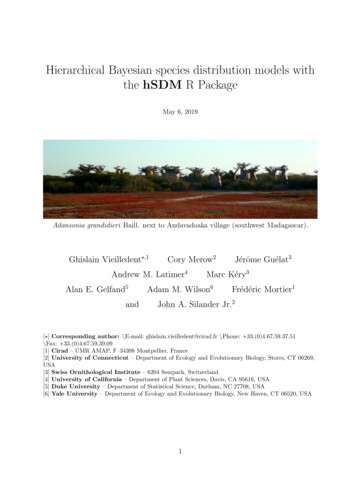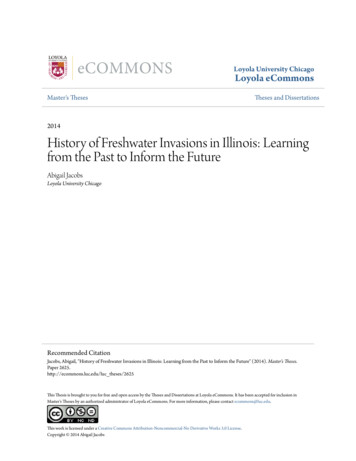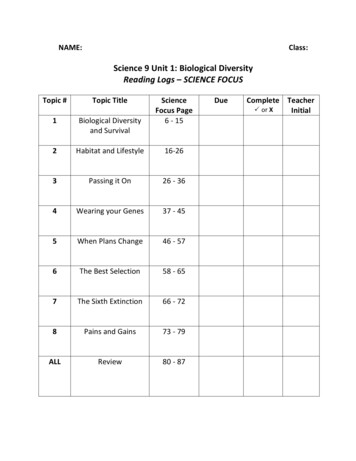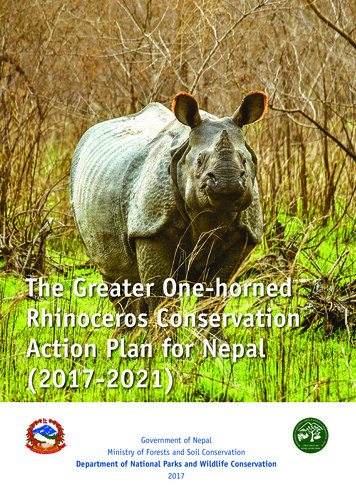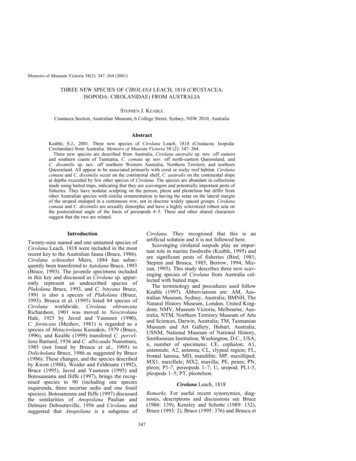
Transcription
Memoirs of Museum Victoria 58(2): 347–364 (2001)THREE NEW SPECIES OF CIROLANA LEACH, 1818 (CRUSTACEA:ISOPODA: CIROLANIDAE) FROM AUSTRALIASTEPHEN J. KEABLECrustacea Section, Australian Museum, 6 College Street, Sydney, NSW 2010, AustraliaAbstractKeable, S.J., 2001. Three new species of Cirolana Leach, 1818 (Crustacea: Isopoda:Cirolanidae) from Australia. Memoirs of Museum Victoria 58 (2): 347–364.Three new species are described from Australia, Cirolana australis sp. nov. off easternand southern coasts of Tasmania, C. comata sp. nov. off north-eastern Queensland, andC. dissimilis sp. nov. off northern Western Australia, Northern Territory and northernQueensland. All appear to be associated primarily with coral or rocky reef habitat. Cirolanacomata and C. dissimilis occur on the continental shelf, C. australis on the continental slopeat depths exceeded by few other species of Cirolana. The species are abundant in collectionsmade using baited traps, indicating that they are scavengers and potentially important pests offisheries. They have nodular sculpting on the pereon, pleon and pleotelson but differ fromother Australian species with similar ornamentation in having the setae on the lateral marginof the uropod endopod in a continuous row, not in discrete widely spaced groups. Cirolanacomata and C. dissimilis are sexually dimorphic and have a highly sclerotized robust seta onthe posterodistal angle of the basis of pereopods 4–5. These and other shared characterssuggest that the two are related.Cirolana. They recognised that this is anartificial solution and it is not followed here.Scavenging cirolanid isopods play an important role in marine foodwebs (Keable, 1995) andare significant pests of fisheries (Bird, 1981;Stepien and Brusca, 1985; Berrow, 1994; Mizzan, 1995). This study describes three new scavenging species of Cirolana from Australia collected with baited traps.The terminology and procedures used followKeable (1997). Abbreviations are: AM, Australian Museum, Sydney, Australia; BMNH, TheNatural History Museum, London, United Kingdom; NMV, Museum Victoria, Melbourne, Australia; NTM, Northern Territory Museum of Artsand Sciences, Darwin, Australia; TM, TasmanianMuseum and Art Gallery, Hobart, Australia;USNM, National Museum of National History,Smithsonian Institution, Washington, D.C., USA;n, number of specimens; CE, cephalon; A1,antennule; A2, antenna; CL, clypeal region; FL,frontal lamina; MD, mandible; MP, maxilliped;MX1, maxillule; MX2, maxilla; PE, penes; PN,pleon; P1-7, pereopods 1–7; U, uropod; PL1-5,pleopods 1–5; PT, pleotelson.IntroductionTwenty-nine named and one unnamed species ofCirolana Leach, 1818 were included in the mostrecent key to the Australian fauna (Bruce, 1986).Cirolana schioedtei Miers, 1884 has subsequently been transferred to Aatolana Bruce, 1993(Bruce, 1993). The juvenile specimens includedin this key and discussed as Cirolana sp. apparently represent an undescribed species ofPlakolana Bruce, 1993, and C. binyana Bruce,1991 is also a species of Plakolana (Bruce,1993). Brusca et al. (1995) listed 84 species ofCirolana worldwide. Cirolana obtruncataRichardson, 1901 was moved to NeocirolanaHale, 1925 by Javed and Yasmeen (1990),C. fornicata (Mezhov, 1981) is regarded as aspecies of Metacirolana Kussakin, 1979 (Bruce,1996), and Keable (1999) transfered C. porcellana Barnard, 1936 and C. albicauda Nunomura,1985 (not listed by Brusca et al., 1995) toDolicholana Bruce, 1986 as suggested by Bruce(1986). These changes, and the species describedby Kwon (1988), Weider and Feldmann (1992),Bruce (1995), Javed and Yasmeen (1995) andBotosaneanu and Iliffe (1997), brings the recognised species to 90 (including one speciesinquirenda, three incertae sedis and one fossilspecies). Botosaneanu and Iliffe (1997) discussedthe similarities of Anopsilana Paulian andDelmare Deboutteville, 1956 and Cirolana andsuggested that Anopsilana is a subgenus ofCirolana Leach, 1818Remarks. For useful recent synonymies, diagnoses, descriptions and discussions see Bruce(1986: 139), Kensley and Schotte (1989: 132),Bruce (1993: 2), Bruce (1995: 376) and Brusca et347
348S. J. KEABLEal. (1995: 17). Revisionary work has providedincreasingly narrower and more practical morphological limits to Cirolana with the transfer ofmany species to other genera (e.g. Bruce, 1981a;1993). Three informal subgroups of Cirolanahave also been proposed by Bruce (1986, 1995):(1) the “C. parva group”; (2) the “C. southerngroup”; and (3) the “C. tuberculate group”. Thenew species described here (and several others)cannot be unambiguously placed in any group:the rostrum does not meet the frontal lamina andthere is some sculpting on the body segments ofall three species eliminating them from the“C. parva” group; and they cannot be members ofthe “C. southern” or the “C. tuberculate” groupsbecause they have continuous setae on the lateralmargin of the uropod exopod. This, combinedwith the character conflict which exists betweenthese informal groups, suggests that they may bebased on plesiomorphic or homoplastic characters. A phylogenetic analysis to resolve this issueis needed.All species of Australian Cirolana with nodularsculpting in the form of tubercles, and that areotherwise similar to the three new species, havethe uropod exopod lateral margin with discontinuous plumose setae (i.e. occurring inwidely spaced groups) and fewer robust setae, orthe rostrum meeting the frontal lamina.A close relationship between Cirolana comatasp. nov. and C. dissimilis sp. nov. is suggested bymany similarities, in particular correspondingsexually dimorphic characters rare in species ofCirolana (Bruce, 1986: 140). Both have a highlysclerotized robust seta on the posterodistal angleof the basis of pereopods 4–5 (4–6 in C. comata).This character does not occur in C. australissp. nov., nor in C. australiense Hale, 1925,C. capricornica Bruce, 1986 or C. similis Bruce,1981b (specimens AM P47660, P47668, P47669examined). Its distribution is otherwise undocumented. Additionally, an iridescent brush formedby the aesthetascs of the antennule (Keable, 1998;Parker, in prep.) was found in both C. comata andC. dissimilis but not C. australis.The three new species appear to be associatedprimarily with coral or rocky reefs. Cirolanacomata and C. dissimilis occur on the continentalshelf, C. australis on the continental slope. Of thespecies currently placed in Cirolana or incertaesedis, only C. bisulcata Hobbins and Jones, 1993,C. bougaardti Kensley, 1984, C. meseda Hobbinsand Jones, 1993, C. vanhoeffeni Nierstrasz, 1931and C. stebbingi Nierstrasz, 1931 are known fromsimilar or greater depths than C. australis.Cirolana australis sp. nov.Figures 1–3Cirolana new species.—Koslow and GowlettHolmes, 1998: 41.Cirolana n.sp. 4.—Lowry, 1998: 63, 64.Material examined. Holotype. Main Pedra Seamount,off southern Tasmania (44 15.6 S 147 7.8 E), baitedtrap, 1,312 m, 21–24 Jan 1997 (CSIRO CruiseSSO1/97, stn 8), AM P59351 (male, 23 mm).Paratypes. All same data as holotype. AM P59352(977 specimens); BMNH 2000.2408–2409 (male,female); NMV J47153 (male, female); TM G3588 (2females); USNM 296460 (male, female).Additional material. E of Fortescue Bay, Tasmania(43 08.96 S 145 15.36 E), baited trap, 5.1 C, 1000 m,J. Lowry and P. Freewater, 16–17 Apr 1993 (stn SEASTAS-365), AM P59353 (2 females, 1 male, 6 mancas);stn SEAS TAS-367, AM P59354 (7 females, 1 male, 5mancas).Diagnosis. Cephalon: rostrum not extending tofrontal lamina, not dividing antennules; anteriormargin not overriding antennules. Eyes: welldeveloped, round. Frontal lamina: anterior marginangled. Pereonites: 1–7 with 2 transverse carinae;4–7 with tubercles. Pleonites: 3–5 with tubercles.Pleonite 4: ventral margin free of pleonite 3; posterodorsal margin apex broadly rounded dorsallybut meeting convex ventral margin at a point.Pleotelson: dorsal surface with paired tubercles inrows, (3 in each row, forming an indistinct ridgeparallel to each lateral margin), conspicuous finesetae absent; anterolateral margins convex; posterolateral margins concave; apex truncate; 2–6(usually 2 or 4) robust setae across apex. Penes:present. Pereopod 1: propodus without plumosesetae. Pereopods 4–6: basis posterodistal anglerobust setae absent. Pleopod 2 appendix masculina: arising subbasally; extending beyond tipof endopod, 1.46 length of endopod from insertion point; margins sinuate, tapering along entirelength; slender; apex not at angle to margins,bluntly rounded. Uropods: endopod not dimorphic; lateral margin straight for proximal twothirds, convex at distal third; exopod not dimorphic; lateral margin straight, robust and plumosesetae continuous along margin.Additional descriptive characters based on holotype.Body: length approximately 2.6 greatest width; white inalcohol; chromatophores absent; cuticular surfacesscale-like.Cephalon: tubercles absent. Eyes: visible in ventralview; black in alcohol; partially overlapped by pereonite 1; ommatidia in rows, 7 ommatidia in horizontaldiameter, 7 ommatidia in vertical diameter. Interocularfurrow: distinct, not extending across cephalon. Frontallamina: length approximately 1.9 basal width; penta-
THREE NEW SPECIES OF CIROLANAFigure 1. Cirolana australis sp. nov., holotype. Scales 0.5 mm.349
350S. J. KEABLEFigure 2. Cirolana australis sp. nov., holotype. Scales 0.5 mm.gonal; lateral margins divergent; apex not projecting,not visible in dorsal view, not expanded, in 1 plane (notstepped). Clypeus: triangular, not produced.Pereonites: 4–7 length subequal and longest, 1–3subequal; tubercles small, fine, subequal, continuousacross entire posterior margin.Pleonites: 1–5 equally visible along dorsal margin;tubercles small, subequal, continuous across entireposterior margin.Pleotelson: length 0.85 basal width; anterodorsaluropodal sutures present; 4 robust setae across apex;plumose setae restricted to posterolateral margins,numerous proximal to robust setae.Antennule: just reaching pereonite 1. Peduncularbases touching; articles 1–2 free; article 1 length lessthan width, subequal to article 2; article 2 longer thanwide, with a few scattered slender and penicillate setae;article 3 longer than combined lengths of articles 1–2,length greater than width. Flagellum shorter thanpeduncle; articles not compressed (lengths of mostgreater than half width); 8-articulate; aesthetascs not iridescent. Antenna: 0.3 length of body, when extendedagainst body reaching to posterior of pereonite 3.Peduncular article 2 shorter than article 3; article 4much longer than article 3, posterodistal angle with 4slender setae, anterodistal angle with 5 slender setae;article 5 subequal in length to article 4, posterodistalangle with 2 penicillate and 2 slender setae, anterodistal
THREE NEW SPECIES OF CIROLANA351Figure 3. Cirolana australis sp. nov., holotype. Scales 0.5 mm.angle with 1 penicillate and 7 slender setae. Flagellum19-articulate; setal brush absent.Mandible: molar medial surface covered with shortfine slender setae, cluster of long slender setae proximally present, long slender setae in submarginal rowacross 0.75 length of anterior margin; marginal robustsetae close set. Setal row with 15 robust setae; medialsurface covered in fine setae. Maxillule: medial lobelateral margin protuberance absent; lateral lobe with10 robust setae on distal surface and 2 slender setae.Maxilla: lateral lobe with 4 plumose and 1 slendersetae; medial lobe with 14 plumose setae, medialplumose setae subequal to proximal setae; middle lobewith 4 plumose and 8 slender setae. Maxilliped: rightendite with 1 coupling hook, left endite with 2 couplinghooks.
352S. J. KEABLEPereopods: 1–3 merus posterior margin robust setaestrongly molariform on 1 only; 2–7 coxal furrows complete. Pereopod 1: posterior margin setose fringeabsent; propodus robust; dactylus shorter than 0.5propodus length.Penes: separated by more than width of both penes;forming flattened lobes; length approximately 1.5 basalwidth.Pleopods: exopod suture complete on 3–5. Pleopod1: exopod medial margin tapering evenly, proximolateral robust seta present; endopod shorter than exopod,lateral margin slightly concave.Uropods: extending beyond pleotelson. Peduncleventrolateral angle without robust setae, with 13plumose setae; lateral margin robust seta absent; distolateral angle rounded. Endopod medial margin convex,with 5 robust setae, plumose setae along entire length;apex subbifid with lateral spine largest, with 1 minutemedial robust seta, setal cluster formed by plumose andslender setae; lateral margin with 4 robust setae,plumose setae along entire length. Exopod 0.94 lengthof endopod; medial margin convex, with 4 robust setae,plumose setae along entire length; apex subequallybifid, without robust setae, setal cluster formed byslender setae; lateral margin with 7 large robust setae,plumose setae along entire length.Sexual dimorphism. Females differ from malesonly in the primary sexual characters.Variation. Pleotelson and uropod robust setalcounts from margins (N 20, subsample of 10males and 10 females from AM P59352): Pleotelson: 1:1 (30%), 2:1 (40%), 2:2 (25%), 3:3 (5%).Endopod: (medial) 5 (10%), 6 (70%), 7 (20%);(lateral) 3 (65%), 4 (35%). Exopod: (medial) 4(75%), 5 (25%); (lateral) 5 (10%), 6 (40%), 7(45%), 8 (5%). Subadult males (19 mm, AMP59352) have the vas deferens opening almostflush to the surface of the sternite and theappendix masculina inserted submedially.Size range. Mancas approximately 7 mm, adultsto approximately 25 mm.Etymology. Australis, Latin, southern, referring tothe position of the type locality.Distribution. Eastern and southern Tasmania;1000–1312 metres.Remarks. Cirolana australis is most readily differentiated by the ornamentation of the somites,coupled with the sinuate lateral margins and truncate apex of the pleotelson, low number of robustsetae on the pleotelson apex, straight lateral margins of the uropod rami, and continuous distribution of the robust and plumose setae along theuropod exopod lateral margin. Other species ofCirolana in which robust setae occur on the margins of the pleotelson usually have six or more,but four have also been recorded in C. rugicaudaHeller, 1861. Cirolana rugicauda is distinguishedfrom C. australis by (in C. rugicauda): therounded apex of the frontal lamina; the projectingclypeus (a character which has been used to diagnose genera and groups of genera excludingCirolana, e.g. Bruce (1986)); and pleonite 3enclosing pleonite 4 (Vanhöffen, 1914; Barnard,1940; Kensley, 1978). Cirolana sulcata Hansen,1890 and Cirolana transcostata Barnard, 1959may be difficult to distinguish from C. australisbut have a frontal lamina with a rounded apex,and uropods with lateral margins that are moreconvex. Cirolana tuberculata (Richardson, 1910)is also similar but has more prominent tubercleson the pleotelson and uropods with convex lateralmargins (Delaney, 1986).Cirolana comata sp. nov.Figures 4–6Material examined. Holotype. Portlock Reef, CoralSea, Queensland (9 42.10 S 144 50.17 E), baited trap,unknown substrate, 65 m, S. Keable, 28 Jan 1993 (stnQLD-775), AM P59355 (male, 13 mm).Paratypes. All same data as holotype, AM P39356(298 specimens); BMNH 2000.2410–2411 (male,female); NMV J47152 (male, female); USNM 296461(male, female).Additional material. Off Flynn Reef, Queensland(16 41.32 S 146 18.26 E), baited trap, unknown substrate, 100 m, J. Lowry, P. Freewater and W. Vader, 7Jun 1993 (stn SEAS QLD-937), AM P47678 (10 specimens); E of Fitzroy Reef, Queensland (23 32.53 S152 16.45 E), baited trap, unknown substrate, 105 m, J.Lowry, P. Freewater and R. Springthorpe, 16 Jun 1993(stn SEAS QLD-956), AM P47675 (13 specimens).Diagnosis. Cephalon: rostrum not extending tofrontal lamina, not dividing antennules; anteriormargin not overriding antennules. Eyes: welldeveloped, round with upper margin flat. Frontallamina: anterior margin angled. Pereonites: without transverse carina; tubercles absent (except for6 indistinct tubercles on submarginal anteriorridge of pereonite 1 in mature males). Pleonites:3–5 with tubercles. Pleonite 4: ventral margin freeof pleonite 3; posterodorsal margin apex broadlyrounded dorsally but meeting convex ventralmargin at a point. Pleotelson: dorsal surface with2 paired tubercles, conspicuous fine setae formingdense patch in males; anterolateral marginsalmost straight and angling posteriorly towardmidline; posterolateral margins straight, contiguous with anterolateral margins; apex rounded;8–11 (usually 10) robust setae on margins. Penes:present. Pereopod 1: propodus without plumose
THREE NEW SPECIES OF CIROLANAFigure 4. Cirolana comata sp. nov., holotype. Scales 0.2 mm.353
354S. J. KEABLEFigure 5. Cirolana comata sp. nov., holotype. Scales 0.5 mm.setae. Pereopods 4–6: basis posterodistal anglewith 1 strongly sclerotized robust seta. Pleopod 2appendix masculina: arising subbasally; extending beyond tip of endopod, 1.22 length ofendopod from insertion point; margins straight,parallel along most of length, but tapering towardapex; slender; apex not at angle to margins,tapered to finely acute point. Uropods: endopoddimorphic, males with dorsal setae; lateral marginslightly convex. Exopod dimorphic, males withdorsal setae; lateral margin convex, robust andplumose setae continuous along margin.Additional descriptive characters based on holotype.Body: length approximately 3.35 greatest width; creamin alcohol; chromatophores, small, brown in alcohol,scattered over body; Cuticular surfaces scale-like.Cephalon: with 4 indistinct tubercles, 2 medially and2 along posterior margin. Eyes: visible in ventral view;orange-tan in alcohol; partially overlapped by pereonite1; ommatidia in rows, 10 ommatidia in horizontaldiameter, 9 ommatidia in vertical diameter. Interocularfurrow: distinct, extending across cephalon, smoothlyconvex. Frontal lamina: length approximately 2 basalwidth; pentagonal; lateral margins parallel; apexnot projecting, not visible in dorsal view, not expanded,in 1 plane (not stepped). Clypeus: triangular, notproduced.Pereonites: 1 longest, 4–6 length subequal and longerthan 2–3 and 7 which are subequal.Pleonites: 1–5 visible but 1 almost completely
THREE NEW SPECIES OF CIROLANAFigure 6. Cirolana comata sp. nov., holotype, except female paratype, 17.5 mm, AMP59356. Scales 0.5 mm.355
356S. J. KEABLEconcealed along dorsal margin by pereonite 7; tuberclesnot continuous across entire posterior margin, pleonite3 tubercles small, subequal, pleonite 4 median tuberclesprominent, pleonite 5 lateral tubercles prominent.Pleotelson: length 0.88 basal width; anterodorsaluropodal sutures present; 5 robust setae on eachposterolateral margin; plumose setae restricted toposterolateral margins, numerous proximal to robustsetae.Antennule: just reaching pereonite 1. Peduncularbases touching; articles 1–2 free; article 1 length subequal to width, greater than article 2; article 2 widerthan long, anteromedial margin with 1 penicillate seta,posterodistal angle with 2 penicillate setae; article 3shorter than combined lengths of articles 1–2, longerthan article 1, length greater than width. Flagellumlonger than peduncle; articles not compressed (lengthsof most greater than half width); 16-articulate;aesthetascs iridescent. Antenna: 0.41 length of body,when extended against body reaching to posterior ofpereonite 4. Peduncular article 2 and article 3 subequalin length; article 4 much longer than article 3, with 4slender setae at anterodistal angle, 1 penicillate seta onposteromedial margin, 2 slender setae at posterodistalangle; article 5 longer than article 4 and all otherarticles, with 1 slender and 2 penicillate setae atanterodistal angle, 2 penicillate and 1 slender setae atposterodistal angle. Flagellum 35-articulate; setal brushpresent.Mandible: molar medial surface covered with shortfine slender setae, cluster of long slender setae proximally present, long slender setae submarginal to anterior margin absent; marginal robust setae close set. Setalrow with 11 robust setae; medial surface without setae.Maxillule: medial lobe lateral margin protuberance welldeveloped; lateral lobe with 11 robust setae on distalsurface. Maxilla: lateral lobe with 6 slender setae;medial lobe with 12 slender and 7 plumose setae, with2 medial plumose setae longest and bent; middle lobewith 13 slender setae. Maxilliped: right and left enditewith 2 coupling hooks.Pereopods: 1–3 merus posterior margin robust setaestrongly molariform on 1 only; 2–7 coxal furrows complete. Pereopod 1: posterior margin setose fringeabsent; propodus robust; dactylus long, 0.5–1 propoduslength.Penes: separated by more than width of both penes;forming flattened lobes; length approximately 1.5 basalwidth.Pleopods: exopod suture complete on 3–5 (but indistinct). Pleopod 1: exopod medial margin taperingevenly, proximolateral robust seta present; endopodlength subequal to exopod, lateral margin slightlyconcave.Uropods: extending beyond pleotelson. Peduncleventrolateral angle with 2 robust setae and 1 plumoseseta; lateral margin robust seta present; distolateralangle rounded. Endopod medial margin convex, with 6robust setae, plumose setae along entire length; apexsubbifid with lateral spine largest, without robust setae,setal cluster formed by plumose and slender setae; lateral margin with 2 robust setae, plumose setae alongentire length. Exopod 0.86 length of endopod; medialmargin convex, with 3 robust setae, plumose setae ondistal two-thirds; apex subbifid with lateral spinelargest, without robust setae, setal cluster formed byslender setae; lateral margin with 6 large robust setae,plumose setae along entire length.Sexual dimorphism. Females differ from males inthe primary sexual characters and do not developthe dense patches of setae found on the dorsalsurface of the pleotelson, uropod endopod anduropod exopod, or the prominent lateral tubercleson pleonite 5 and dense brush of setae formed onthe proximal articles of the antennal flagellum.The tubercles on the cephalon, pereonite 1,pleonites 3–4 and on the pleotelson are alsoabsent in females.Variation. Pleotelson and uropod robust setalcounts from margins (N 20, subsample of 10males and 10 females from AM P39356): Pleotelson: 4:4 (5%), 4:5 (5%), 5:5 (85%) , 5:6 (5%).Endopod: (medial) 5 (70%), 6 (30%); (lateral) 1(5%), 2 (95%). Exopod: (medial) 2 (5%), 3(95%); (lateral): 5 (65%), 6 (35%). Males approximately 6 mm long lack tubercles, and the dorsalsetae on the pleotelson and uropods.Size range. Mancas approximately 3 mm, adultsapproximately 5–17.5 mm.Etymology. Comata, Latin, hairy, referring to thedense setae found on the dorsal surfaces of thepleotelson and uropod rami in mature males.Distribution. Off north-east Queensland; 65–105metres.Remarks. The prominent lateral tubercles onpleonite 5 and the dense patch of setae on thepleotelson distinguish mature males of Cirolanacomata and C. dissimilis from those of otherspecies in the genus. Cirolana comata differsfrom C. dissimilis in having a dense patch of setaeon the dorsal surface of the uropod rami, a setalbrush on the antenna in mature males and astrongly sclerotized robust seta at the posterodistal angle of the basis of pereopods 4–6 (4–5 inC. dissimilis). Females and immature males ofC. comata and C. dissimilis are difficult to distinguish from other species but the lack of chromatophores, lack of strong tubercles or othersculpting on the somites, rostrum not extending tothe frontal lamina, relatively high number ofrobust setae on the pleotelson, shape of the pleotelson, presence of a strongly sclerotized robustseta at the posterodistal angle of the basis of pereopods 4–5 (C. dissimilis), or 4–6 (C. comata), andthe continuous distribution of the robust and
THREE NEW SPECIES OF CIROLANAplumose setae along the uropod exopod lateralmargin are diagnostic. Cirolana indica Nierstrasz, 1931, which is only known from a singlefemale which lacks tubercles or ridges, may besimilar to C. comata and C. dissimilis. However,C. indica is described as having a row of plumosesetae along the posterodistal angle of the propodus of pereopod 1 which is lacking in thesespecies. Cirolana meinerti Barnard, 1920 apparently has a patch of setae on the dorsal surface ofthe pleotelson and may also be similar toC. comata and C. dissimilis in other respects.However, C. meinerti is described as havingmedial tubercles on pleonite 5 which are moreprominent than the lateral tubercles. This is notthe case in C. comata or C. dissimilis. Maturemales of C. pleonastica Stebbing, 1900 develop adense patch of setae on the dorsal surface of theuropod exopod, as in C. comata. However, theydo not develop a similar patch on the uropodendopod or the pleotelson (Bruce, 1995).Cirolana comata and C. pleonastica are also distinct in many other features including the sculpting of the somites, and the shape and setation ofthe pleotelson.Cirolana dissimilis sp. nov.Figures 7–9Cirolana sp. 1.—Keable, 1997: 251.Material examined. Holotype. Just off West Point, Darwin Harbour, Northern Territory (12 26.3 S129 46.3 E), baited trap, unknown substrate but probably rock reef, 8 m, S. Keable, 8–9 Jul 1993 (stnNT-123), NTM Cr012796 (male, 18 mm).Paratypes. All same data as holotype, AM P44797(40 males, 40 females); BMNH 2000.2412–2413 (male,female); NMV J47151 (male, female); NTM Cr012797(female); USNM 296462 (male, female).Additional material. Bet Reef, Torres Strait, Queensland (10 10.54 S 142 56.01 E), baited trap, grey claymud with shell grit, 20 m, S. Keable, 30–31 Jan 1993,AM P44799 (many specimens). Ngalaguru (HighCliffy) I., Western Australia (15 54.77 S 124 20.68 E),baited trap, unknown substrate, unknown depth, F.Wells, 22–23 Nov 1994, AM P59357 (19 specimens).Diagnosis. Cephalon: rostrum not extending tofrontal lamina, not dividing antennules; anteriormargin not overriding antennules. Eyes: welldeveloped, round with upper margin flat. Frontallamina: anterior margin angled. Pereonites: without transverse carina; tubercles absent (except for4 indistinct tubercles on submarginal anteriorridge of pereonite 1 in mature males). Pleonites:3–5 with tubercles. Pleonite 4: ventral margin free357of pleonite 3; posterodorsal margin apex broadlyrounded dorsally but meeting convex ventral margin at a point. Pleotelson: dorsal surface with 2paired tubercles, conspicuous fine setae formingdense patch in males; anterolateral margins convex; posterolateral margins convex; apexrounded; 8–11 (usually 10) robust setae on margins. Pereopod 1: propodus without plumosesetae. Pereopods 4–6: basis posterodistal anglewith 1 strongly sclerotized robust seta on pereopods 4–5 only. Penes: present. Pleopod 2appendix masculina: arising basally; extendingbeyond tip of endopod, 1.21 length of endopodfrom insertion point; margins straight, parallelalong most of length, but tapering toward apex;slender; apex not at angle to margins, tapered tofinely acute point. Uropods: endopod not dimorphic; lateral margin slightly convex; exopod notdimorphic; lateral margin straight, robust andplumose setae continuous along margin.Additional descriptive characters based on holotype.Body: length approximately 3.6 greatest width; creamin alcohol; chromatophores absent; cuticular surfacesscale-like.Cephalon: with tubercles, 4 indistinct along posteriormargin. Eyes: visible in ventral view; black in alcohol;partially overlapped by pereonite 1; ommatidia in rows,9 ommatidia in horizontal diameter, 8 ommatidia in vertical diameter. Interocular furrow: distinct, extendingacross cephalon, smoothly convex. Frontal lamina:length approximately 2 basal width; pentagonal; lateralmargins concave; apex not projecting, not visible indorsal view, not expanded, in 1 plane (not stepped).Clypeus: triangular, not produced.Pereonites: 1, 4–6 length subequal and longest, 2–3and 7 subequal.Pleonites: 1–5 visible but 1 almost completelyconcealed along dorsal margin by pereonite 7; tuberclesnot continuous across entire posterior margin, pleonites3–4 tubercles small and subequal, pleonite 5 lateraltubercles prominent.Pleotelson: length 0.79 basal width; anterodorsaluropodal sutures present; 5 robust setae on eachposterolateral margin; plumose setae restricted to posterolateral margins, numerous proximal to robust setae.Antennule: just reaching pereonite 1. Peduncularbases touching; articles 1–2 free; article 1 length subequal to width, subequal to article 2; article 2 longerthan wide, with 1 penicillate seta at posterodistal angleand on anterolateral margin; article 3 shorter than combined lengths of articles 1–2, longer than article 1,length greater than width. Flagellum longer than peduncle; articles not compressed (lengths of most greaterthan half width); 19-articulate; aesthetascs iridescent.Antenna: 0.38 length of body, when extended againstbody reaching to posterior of pereonite 4. Pedunculararticle 2 shorter than article 3; article 4 much longerthan article 3, with 1 penicillate seta on posterolateralmargin, 3 slender setae at posterodistal angle; article 5
358S. J. KEABLEFigure 7. Cirolana dissimilis sp. nov., holotype. Scales 0.5 mm.
THREE NEW SPECIES OF CIROLANA359Figure 8. Cirolana dissimilis sp. nov., holotype. Scales 0.5 mm.longer than article 4 and all other articles, with 2penicillate setae at anterodistal angle, 4 slender and 1penicillate setae at posterodistal angle. Flagellum41-articulate; setal brush absent.Mandible: molar medial surface covered with shortfine slender setae, cluster of long slender setae proximally present, long slender setae submarginal to anterior margin absent; marginal robust setae close set. Setalrow with 15 robust setae; medial surface without setae.Maxillule: medial lobe lateral margin protuberance welldeveloped; lateral lobe with 10 robust setae on distalsurface. Maxilla: lateral lobe with 4 slender setae;medial lobe with 4 slender and 14 plumose setae, withmedial plumose seta longest and bent; middle lobe withlateral row of 10
there is some sculpting on the body segments of all three species eliminating them from the . female); NMV J47153 (male, female); TM G3588 (2 females); USNM 296460 (male, female). Additional material. E of Fortescue Bay, Tasmania (43 08.96 S 145 15.36 E), baited trap, 5.1 C, 1000 m,
